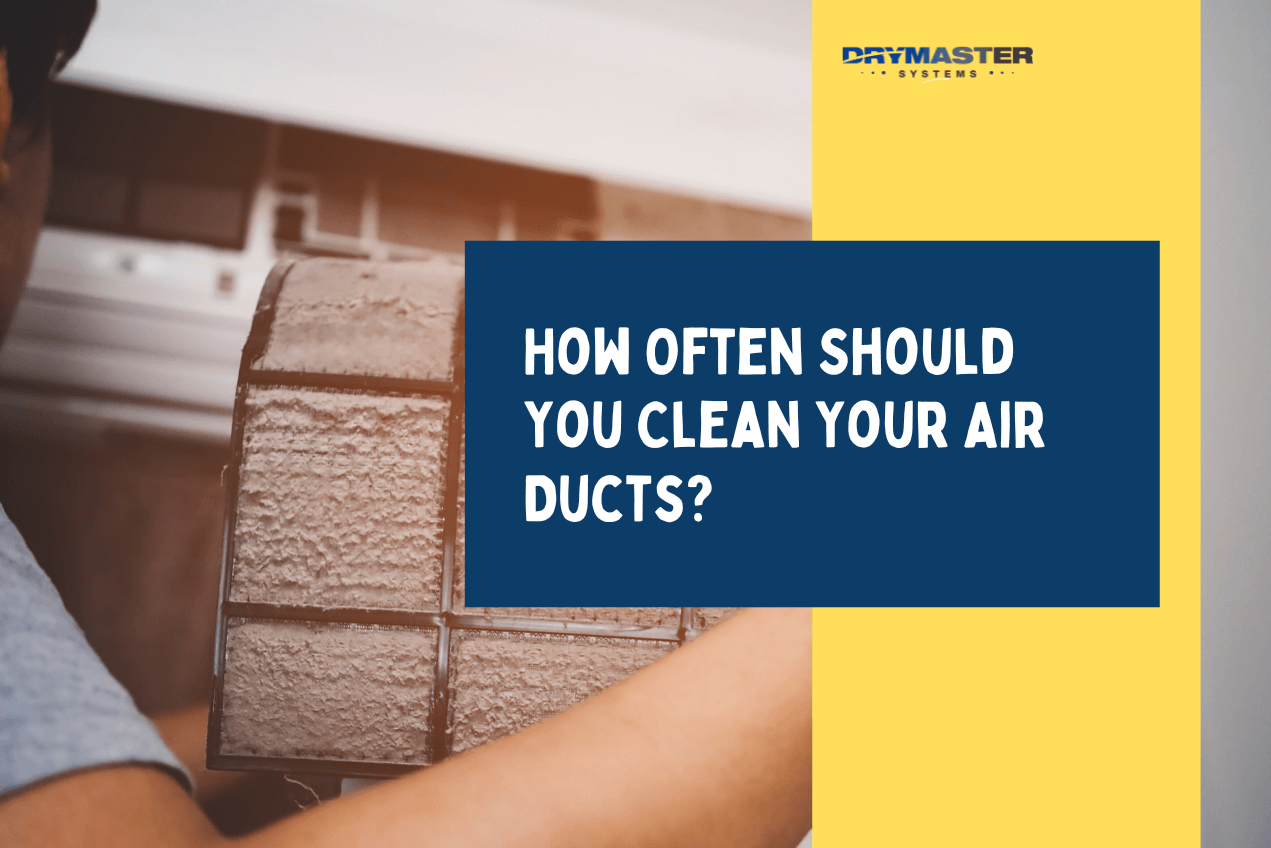Although the EPA doesn’t endorse duct cleaning to address health issues, most spaces can benefit from air duct cleaning every two to five years. The benefits of duct cleaning include the removal of dust, debris, mold, and other toxins. Start your own duct cleaning business with DryMaster Systems.
Air duct cleaning offers home and business owners a way to rid their HVAC systems of excess dust or debris that dirties the air in their space. Although the EPA doesn’t officially endorse duct cleaning as a way to improve health issues caused by poor air quality, growing evidence shows that air duct cleaning services may benefit those living and working in spaces with clean ducts.
Discover the potential benefits of duct cleaning and how often you should clean your air ducts, according to the National Air Duct Cleaners Association (NADCA).
What is Air Duct Cleaning?
Air duct cleaning is a specialized process that clears heating, ventilation, and cooling (HVAC) system ducts of dust, mold, and other potentially harmful debris. In centralized heating and cooling, ducts are a system of insulated tubing that runs throughout a home or office and carries forced air to alter the temperature of a space.
Over time, these tubes, called ducts, gather debris that can affect indoor air quality and potentially cause health issues like:
- Nose, throat, and eye irritation
- Dizziness, fatigue, and headaches
- Respiratory issues
Professionally performed duct cleaning removes harmful toxins by cleaning the HVAC system’s return and supply air registers, ducts, and other components.
Most air duct cleaning services include the following:
- System inspection before cleaning
- Use of specialized vacuum equipment that removes particles from the home or use of HEPA equipment
- Protection of HVAC ducts, including re-insulation or sealing to create an airtight system
Does Cleaning Air Ducts Really Make a Difference?
Although air duct cleaning isn’t an officially endorsed method for treating health issues related to indoor air pollution, evidence exists that cleaning air ducts does make a difference in the air quality of a home or workspace.
The Environmental Protection Agency (EPA) says that dirty air ducts are one of the first signs that you may have undesirable particles in your home. The agency recommends that if you have a fuel-burning device like a fireplace, stove, or furnace, you should have your ducts examined before turning on heating every year.
The National Institute of Health’s Division of Occupational Health and Safety (DOHS) references a 2010 review on duct cleaning. The agency states that duct cleaning was found to be efficient at removing duct contaminants; however, the reduction of indoor air toxins was highly variable.
One study on the effectiveness of HVAC cleaning found that duct cleaning reduced particle counts in homes that were part of the study.
This evidence suggests that HVAC cleaning can reduce wanted particles from indoor air in some circumstances.
How Do You Tell if Your Ducts Need Cleaning?
According to the EPA and DOHS, duct cleaning may be necessary under certain conditions to prevent toxins from harming those breathing in the air from an HVAC system. These conditions include ducts that:
- Signs of persistent or permanent water damage
- Debris build-up restricting airflow
- An offensive or rusty smell
- Discharge dust from supply diffusers
- Observable microbial or slime growth
- Visible mold or black debris build-up
- Signs of a pest infestation such as vermin or insect droppings
If you suspect mold in your HVAC ducts, the EPA suggests having a sample tested to confirm the substance. Some mold is toxic and requires you to shut off your HVAC system to have the ducts inspected or cleaned to avoid adverse health issues.
What Happens if You Don’t Clean Air Ducts?
For homes with ducts that fall under the EPA’s cleaning recommendations, not cleaning the ducts can have negative consequences. Ducts not properly installed or exposed to consistent moisture have the highest chances of microbial growth that can release toxins into the living space.
Uncleaned air ducts can result in the following issues:
Allergic reactions
Contaminants like dust, mold, and mildew can cause some people breathing issues or allergic reactions. Failure to remove these toxins can cause continued build-up and further indoor air quality issues.
Poor air quality
Not having ducts inspected or cleaned when necessary can result in generally poor air quality. People with asthma or other respiratory illnesses may suffer from flare-ups or exacerbated symptoms caused by a buildup of dust and debris.
Restricted airflow
Restricted airflow caused by excessive debris build-up in HVAC ducts can contribute to the spread of airborne pathogens. Regularly cleaning your air ducts can remove this dust and debris to aid airflow throughout the home or office space. It can also improve HVAC system efficiency and reduce energy costs when heating or cooling a home.
Damage to ducts or HVAC components
If left for too long, ducts exposed to moisture or rodents can suffer damage. Insects and vermin may chew or tear through ductwork, creating leaks or holes through which additional toxins can enter and air escapes. Moisture can cause water damage over time, likening the chances of harmful mildew or mold growth. Damaged ducts also reduce the system’s energy efficiency, costing you more in utility bills long-term.
How Often Should You Clean Your Air Ducts?
The NADCA recommends cleaning your air ducts every three to five years or as needed. They also suggest that an air duct cleaner visit your home once per year to assess whether your environment is more susceptible to bacteria, mold, or other toxins and requires more frequent cleaning. For example, people living in a home with pets, smokers, or recently renovated may need to have their ducts cleaned more often. The NADCA also suggests cleaning your ducts when you move into a new home or build a new house.
When working with a duct cleaning company, ensure they charge between $400 and $1,000. Too low of a price indicates a get-rich-quick company, and higher than $1,000 for most residential homes is unnecessary. The NADCA suggests that effective duct cleaners should take a few hours to do the job, use vacuum systems with HEPA technology, and follow NADCA standards.
Start Your Own Duct Cleaning Business With DryMaster
To learn more about air duct cleaning or provide air duct cleaning services for residential or commercial properties, request a free business guide on how to start an air duct cleaning business. When you join the DryMaster Affiliate program, you gain access to valuable resources such as a helpful getting started guide, personal coaching, marketing materials, and access to superior equipment, all for an affordable start-up investment.
Contact us today to start an air duct cleaning business with DryMaster Systems and reap the benefits of owning your own profitable cleaning company.




